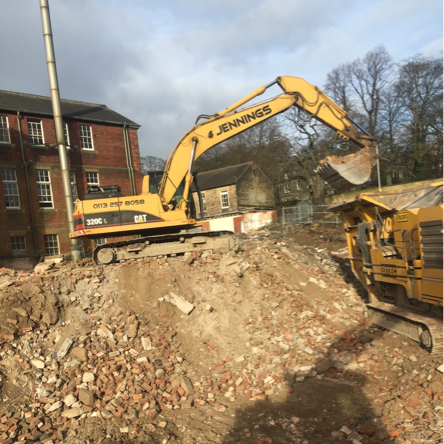
04 Aug Things to consider before starting a residential demolition project
Have a demolition project on the horizon? Whether it’s an old barn, windmill or three-storey house, successful residential demolition depends on proper planning and using the right techniques to get the job done.
In this mini guide, we’re going to list some of the things to consider before starting a residential demolition project. Have a read through it and take heed of our advice to ensure your demolition project goes smoothly.
Demolition techniques
Residential demolition projects are considered small-scale. This means that implosion (the coolest and most complex demolition method) is off the cards. What you’re left with is two ways to demolish a residential building:
1. Mechanically or manually using hydraulic equipment
Demolishing a building mechanically or manually using hydraulic equipment is relevant to projects where the building just needs to come down. This demolition technique isn’t sympathetic to building materials and has the sole aim of breaking up structure. It’s very effective and efficient. Most residential demolition projects are carried out in this way due to it being cost-effective and fast.
2. Deconstruction by hand
Deconstruction by hand is sympathetic to building materials and preserves them far better than mechanical demolition. This technique involves a skilled workforce painstakingly deconstructing a building from top to bottom by hand. It is relevant where the materials in the building are valuable and can be reused. Examples include wooden beams, iron wrought and metalwork, granite slabs and stones.
You can also use a combination of these techniques to suit the building. This isn’t always relevant, but it should be considered if there are some reusable period materials present in the building. Make sure you identify these before work commences.
Planning permission
The process of demolishing a house or outbuilding beneath three storeys is a relatively simple task and it is normally classed as permitted development. This means most projects can proceed without notifying the local planning authority.
Exceptions apply in Conservation Areas and wherever buildings are Listed. If this applies to you, speak with your local planning authority for guidance.
The local environment
When a building is demolished its environmental impact must be considered. In rural areas, it is standard practice to hire an ecologist to carry out a wildlife survey and we also recommend this in urban areas. If the presence of an endangered species is detected, then it is likely a further report will be required.
The results of an ecological survey can place some conditions on demolition. These conditions typically include the time of year demolition work can commence and any further mitigation measures if required.
One thing to shake out of your head is the prospect of your demolition project being refused due to the ecological report. This never happens, because permitted development rights hold true even under survey. The survey can merely place restrictions on the demolition and if you agree to them, demolition can proceed.
Asbestos
The Control of Asbestos Regulations 2012 make it the responsibility of the duty holder to identify the location and condition of asbestos containing materials. If identified, a written asbestos management plan is a legal requirement.
Asbestos surveys satisfy the criteria of identifying the location and condition of asbestos containing materials. Often, the surveyor can also assist with the written asbestos management plan, so you can kill two birds with one stone. The size and scale of surveys differs depending on the project. Residential demolition projects should have an inspection survey carried out with a reputable company.
It’s important to remember that asbestos is a fibrous silicate that causes cancer and respiratory disease when inhaled. It is extremely hazardous and should be treated as such.
Health and safety
Demolition projects have a unique set of hazards, from unplanned structure collapse and falling debris to tripping hazards and electrocution. If you use a professional demolition company such as Jennings, site health and safety is project managed to ensure everyone on site is kept as safe as is reasonably possible.
If you are demolishing a building yourself, we advise you to read the latest demolition guidance from the Health and Safety Executive. You must take all reasonable measures to protect yourself and others during demolition.
For any matters of concern regarding site health and safety, you can hire advisors out to survey your site or a demolition company for a fee. We always recommend speaking with a demolition health and safety expert prior to starting work. A fresh pair of eyes is sometimes all it takes to make sites considerably safer for everyone.


No Comments